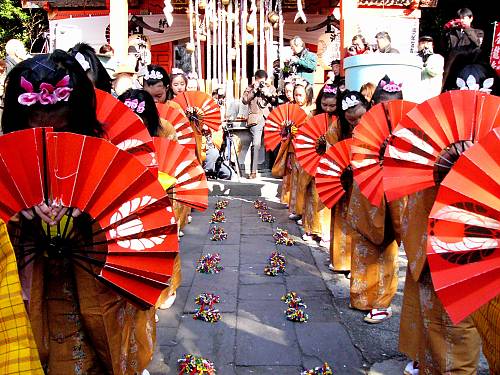Chakkirako
Inscribed in 2009 (4.COM) on the Representative List of the Intangible Cultural Heritage of Humanity
Country(ies): Japan
Identification
Description

- Chakkirako
- © 2007, by Miura City Board of Education
Located on a peninsula in Kanagawa Prefecture in central Japan, Miura City developed as a military port on the Pacific and a harbour providing shelter to passing ships. Drawing on dances from other cities demonstrated to them by visiting sailors, the people of Miura began the tradition of Chakkirako to celebrate the New Year and bring fortune and a bountiful catch of fish in the months to come. By the mid-eighteenth century, the ceremony had taken its form as a showcase for the talent of local girls. Every year in the middle of January, at a shrine or before the houses of the community, five to ten women from age forty to eighty sing a capella to accompany the dancing of ten to twenty young girls in colourful kimonos. The dancers perform face-to-face in two lines or in a circle, holding fans before their faces in some pieces and clapping thin bamboo sticks together in others. The name of the dance, Chakkirako, evokes the sound these sticks make. Transmitted from older women to young girls, Chakkirako employs a medley of centuries-old songs and dances to entertain and reaffirm the continuing cultural identity of the performers and their community.
Documents
- Nomination form: English|French
- Consent of communities: Japanese/English
Decision 4.COM 13.47
The Committee (…) decides that [this element] satisfies the criteria for inscription on the Representative List of the Intangible Cultural Heritage of Humanity, as follows:
- R.1: Chakkirako has been transmitted from generation to generation as a New Year’s celebration for the local people, embodying a connection between ancestral tradition and contemporary art, and providing the community with a sense of identity and continuity;
- R.2: Its inscription on the Representative List would raise awareness regarding the significance of intangible cultural heritage, encourage its transmitters, and promote respect for the cultural diversity and human creativity that it reflects;
- R.3: The Association for the Preservation of Chakkirako has been making various efforts for its transmission to future generations, together with local elementary schools and Boards of Education at the city and prefectural levels, while the national government subsidizes archival recording;
- R.4: The nomination includes evidence of the free, prior and informed consent of the community concerned;
- R.5: The element is inscribed as an Important Intangible Folk Cultural Property on the national inventory maintained by the Agency for Cultural Affairs.
Slideshow
Video
These videos (and many more) can also be consulted through the UNESCO Archives Multimedia website











